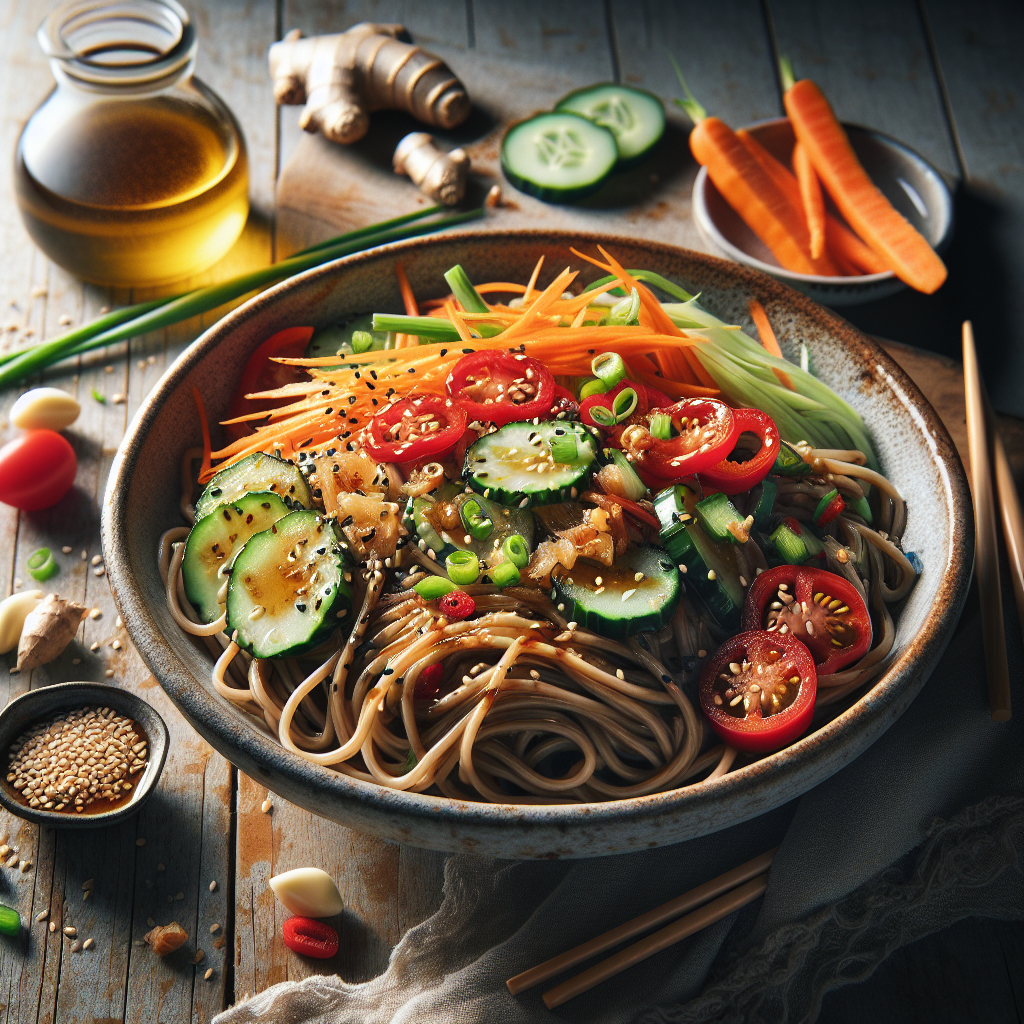
Discover this refreshing Korean-inspired soba noodle salad that perfectly balances sweet, savory, and nutty flavors. With crisp vegetables and a zingy sesame-ginger dressing, this colorful dish is perfect for hot summer days or as a light, healthy meal any time of year.
Ingredients for Fresh Korean-Style Sesame Ginger Soba Noodle Salad
- 10oz Soba Noodles
- 3 tbsp Sesame Oil
- 4 tbsp Soy Sauce
- 2 tbsp Rice Vinegar
- 2 tbsp Fresh Ginger (minced)
- 2 tbsp Garlic (minced)
- 2 tbsp Honey
- 7oz Carrots (julienned)
- 7oz Cucumber (julienned)
- 5oz Red Bell Pepper (thinly sliced)
- 4 whole Green Onions (sliced)
- 2 tbsp Sesame Seeds
Instructions for Fresh Korean-Style Sesame Ginger Soba Noodle Salad
- Cook 10oz soba noodles according to package instructions. Drain and rinse under cold water.
- In a large bowl, whisk together 3 tbsp sesame oil, 4 tbsp soy sauce, 2 tbsp rice vinegar, 2 tbsp minced ginger, 2 tbsp minced garlic, and 2 tbsp honey until well combined.
- Add the cooled noodles to the bowl with the dressing and toss well to coat.
- Add 7oz julienned carrots, 7oz julienned cucumber, and 5oz sliced red bell pepper to the noodles.
- Add 4 whole sliced green onions and toss everything together gently.
- Sprinkle 2 tbsp sesame seeds over the top and serve chilled.
Welcome to My Fresh Korean-Style Sesame Ginger Soba Noodle Salad
As a chef who grew up straddling two culinary worlds, I've always been drawn to dishes that reflect the beautiful fusion of Asian flavors with modern, health-conscious cooking. This Korean-Style Sesame Ginger Soba Noodle Salad is exactly that kind of dish - a harmonious blend of nutty soba noodles, crisp vegetables, and an irresistible sesame-ginger dressing that will make your taste buds dance.
Ready in just 35 minutes, this vibrant salad brings together the earthy buckwheat flavor of soba noodles with the crunch of fresh vegetables and the aromatic punch of sesame and ginger. It's a perfect example of how traditional Asian ingredients can be transformed into a light, refreshing meal that's ideal for contemporary healthy eating.
Whether you're meal prepping for the week ahead or looking for a satisfying lunch that won't weigh you down, this recipe delivers both nutrition and flavor. Each serving packs 11g of protein and a rainbow of vegetables, making it a fantastic option for anyone looking to incorporate more plant-based meals into their diet.
Tips for the Perfect Sesame Ginger Soba Noodle Salad
Let me share some professional insights to help you achieve the best results with this recipe:
-
Don't Skip the Cold Rinse: After cooking your soba noodles, always rinse them thoroughly under cold water. This step isn't just about cooling them down - it removes excess starch and prevents them from becoming sticky and clumping together.
-
Prep Ahead: The vegetables can be julienned up to a day in advance and stored in an airtight container in the refrigerator. This makes assembly a breeze when you're ready to prepare the salad.
-
Temperature Matters: For the best texture and flavor, allow your noodles to cool completely before combining them with the dressing. Warm noodles will absorb too much dressing and become soggy.
-
Dressing Dynamics: If you're making this ahead, consider reserving a small portion of the dressing to refresh the salad just before serving, as the noodles tend to absorb the dressing over time.
-
Vegetable Cutting Technique: Try to keep your vegetable cuts consistent in size - aim for matchstick pieces about 2-3 inches (5-7.5 cm) long for the best presentation and eating experience.
Serving Your Korean-Style Soba Noodle Salad
This versatile salad can be served in multiple ways to suit any occasion. For a casual lunch, serve it in individual bowls topped with extra sesame seeds and a sprinkle of green onions. When presenting it as part of a larger spread, arrange it on a large platter, creating a beautiful display of the colorful vegetables.
Consider serving it alongside some complementary dishes:
- Grilled tofu or chicken skewers
- Korean pickled vegetables (kimchi)
- A light miso soup
- Steamed edamame
The salad keeps well in the refrigerator for up to 3 days, making it perfect for meal prep. Just give it a gentle toss before serving, and if needed, brighten it up with a squeeze of fresh lime juice or a splash of rice vinegar.
A Bowl Full of Memories: My Journey with Soba
The first time I made this Korean-Style Sesame Ginger Soba Noodle Salad, I was transported back to my grandmother's kitchen in California, where she would often prepare traditional Asian noodle dishes with her own American twist. I remember watching her skillfully julienne vegetables, her hands moving with practiced precision, while telling me stories about how she adapted traditional recipes to incorporate local ingredients.
This recipe, in particular, reminds me of the summer potlucks we would have in our backyard, where neighbors would gather under the warm sun, sharing dishes that represented their own cultural heritage. My grandmother's noodle salads were always the first to disappear, and she took such pride in seeing everyone enjoy her food.
Now, when I prepare this soba noodle salad in my own kitchen, I think of those moments and how food has this incredible power to connect generations and cultures. I've added my own touches to the recipe - the honey for a subtle sweetness, the extra crunch of bell peppers - but the soul of the dish remains the same: simple, fresh ingredients coming together to create something truly special.
Making Substitutions in Your Sesame Ginger Soba Noodle Salad
As someone who grew up cooking both traditional Asian dishes and fusion cuisine, I've learned that adaptability is key in the kitchen. While this Korean-inspired soba noodle salad is perfect as written, there are several substitutions you can make while maintaining its delicious essence.
For the noodles, if you can't find soba (buckwheat noodles), you can use whole wheat spaghetti or udon noodles. However, keep in mind that soba's nutty flavor adds a unique dimension to this dish. In a pinch, rice noodles will work too, though the texture will be different.
The dressing components are quite flexible. Can't find rice vinegar? Apple cider vinegar or lime juice can step in, though start with less as they're more potent. For a sugar-free version, replace the honey with maple syrup or agave nectar. The sesame oil, however, is crucial for that authentic Asian flavor – I wouldn't skip it!
As for the vegetables, this salad welcomes substitutions. Here are some of my favorite swaps:
- Carrots: julienned daikon radish or parsnips
- Cucumber: zucchini or yellow squash
- Red bell pepper: any color bell pepper, or even thinly sliced sugar snap peas
- Green onions: chives or thinly sliced red onion
- Sesame seeds: pumpkin seeds or crushed peanuts (though the sesame really adds to the Asian flavor profile)
Nutritional Benefits of This Fresh Noodle Salad
At 320 calories per serving, this soba noodle salad isn't just delicious – it's a nutritionist's dream! Each portion provides 11g of protein, primarily from the buckwheat soba noodles, making it a satisfying choice for vegetarians and vegans. The 12g of healthy fats, mainly from sesame oil, help with vitamin absorption and keep you feeling full longer.
The carbohydrate content (48g) is primarily complex carbs from the soba noodles, providing sustained energy rather than quick spikes in blood sugar. With only 8g of sugar per serving, mostly from natural sources like honey and vegetables, it's a balanced choice for those watching their sugar intake.
This salad is also packed with micronutrients:
- Carrots provide beta-carotene for eye health
- Cucumbers offer hydration and minerals
- Bell peppers are rich in vitamin C
- Ginger and garlic provide anti-inflammatory compounds
- Sesame seeds are excellent sources of calcium and iron
Important Allergy Information
As someone who regularly cooks for people with various dietary restrictions, I always emphasize the importance of being aware of potential allergens. This Korean-inspired soba noodle salad contains several ingredients that could trigger allergies:
- Soba noodles typically contain wheat and buckwheat (though 100% buckwheat versions exist)
- Soy sauce contains soy and wheat (use tamari for gluten-free option)
- Sesame oil and seeds (a common allergen in Asian cuisine)
For those with gluten allergies or celiac disease, ensure your soba noodles are 100% buckwheat and use tamari instead of regular soy sauce. Those with sesame allergies should avoid this recipe or make significant modifications, as the sesame flavor is central to the dish.
Storage Tips for Maximum Freshness
To maintain the optimal texture and flavor of your sesame ginger soba noodle salad, proper storage is crucial. The salad will keep in an airtight container in the refrigerator for up to 3 days, though it's best consumed within the first 48 hours.
Pro tips for storage:
- Store the dressing separately if preparing in advance
- Keep cut vegetables separate until ready to serve
- If fully assembled, store in an airtight container with minimal air space
- Don't freeze this salad – the vegetables will become mushy and the noodles' texture will suffer
When ready to serve from the refrigerator, let it sit at room temperature for 10-15 minutes and give it a gentle toss to redistribute the dressing.
Frequently Asked Questions
Can I make this salad ahead of time? Yes! You can prep components up to 2 days ahead. Store noodles, dressing, and vegetables separately until ready to serve.
Is this recipe vegan? Yes, if you substitute the honey with maple syrup or agave nectar.
Can I serve this salad warm? While traditionally served cold, it can be enjoyed at room temperature. I don't recommend serving it hot as it may wilt the fresh vegetables.
How spicy is this dish? It's not spicy at all, but you can add red pepper flakes or sriracha to taste.
Can I add protein to this salad? Absolutely! Tofu, grilled chicken, or shrimp work wonderfully.
The Perfect Fusion of Flavors and Health
This Korean-Style Sesame Ginger Soba Noodle Salad represents everything I love about Asian fusion cuisine – it's a harmonious blend of textures and flavors that manages to be both satisfying and light. The combination of nutty soba noodles, crisp vegetables, and aromatic sesame-ginger dressing creates a dish that's greater than the sum of its parts.
What makes this recipe special is its versatility – it's perfect for meal prep, elegant enough for entertaining, and adaptable to various dietary needs. As someone who bridges traditional Asian cooking with modern healthy eating, I'm proud to share this recipe that honors both worlds while being accessible to home cooks of all skill levels.
Whether you're looking for a light summer meal, a healthy lunch option, or a colorful addition to your dinner table, this soba noodle salad delivers on all fronts. It's a testament to how traditional Asian ingredients can be transformed into contemporary dishes that appeal to modern palates while maintaining their cultural essence.
